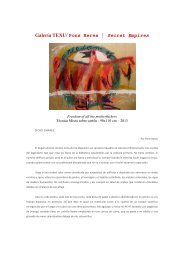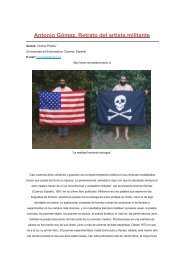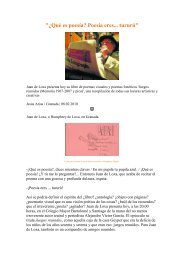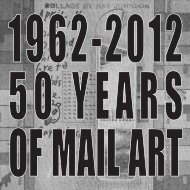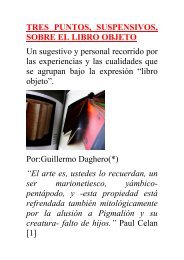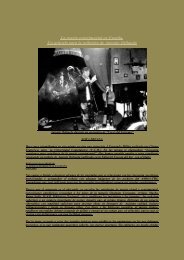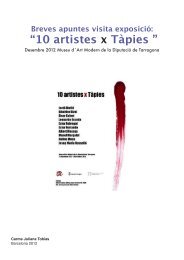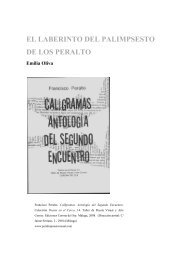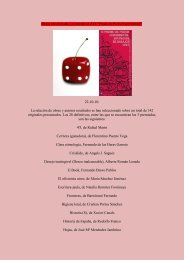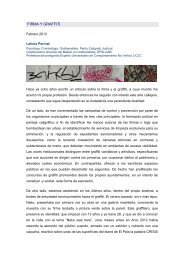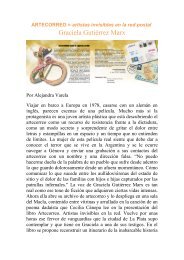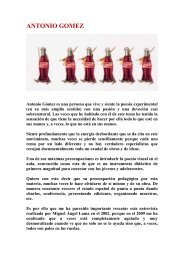MUAC / Enrique Jezik / Obstruir, destruir, ocultar. - Boek 861
MUAC / Enrique Jezik / Obstruir, destruir, ocultar. - Boek 861
MUAC / Enrique Jezik / Obstruir, destruir, ocultar. - Boek 861
Create successful ePaper yourself
Turn your PDF publications into a flip-book with our unique Google optimized e-Paper software.
Museo Universitario Arte Contemporaneo, <strong>MUAC</strong><br />
<strong>Enrique</strong> Ježik<br />
<strong>Obstruir</strong>, <strong>destruir</strong>, <strong>ocultar</strong>.<br />
11.06.2011 / 27.11.2011<br />
Ciclo Fantasmas de la libertad 2010-2011<br />
A lo largo de dos décadas, marcadas por su traslado de Argentina a México en 1990,<br />
<strong>Enrique</strong> Ježik (Córdoba, Argentina, 1961) ha desplegado un complejo trabajo de<br />
exploración de las estructuras y dispositivos de fuerza, vigilancia, represión, control y<br />
violencia, desde el interior de la práctica polimorfa de la escultura contemporánea.<br />
Para <strong>Enrique</strong> Ježik, la escultura es un modo de pensar al poder y la violencia como un<br />
terco accionar sobre la materia de los cuerpos. Sus performances, videos e<br />
intervenciones específicas, que involucran tácticas que van desde el uso de las balas<br />
hasta la escritura en braille, atestiguan una etapa histórica donde los medios de<br />
destrucción y las tecnologías de control crean los espacios, metáforas, dispositivos y<br />
trayectorias de la política.<br />
<strong>Obstruir</strong>, <strong>destruir</strong>, <strong>ocultar</strong> despliega por primera vez un panorama de las obras y<br />
proyectos de un artista que ha sido una pieza crucial del relato del arte<br />
contemporáneo mexicano. Organizada en seis secciones que refieren a conceptos de<br />
los dispositivos, espacios y operaciones de la violencia (obstrucción, destrucción,<br />
ocultamiento, el cuerpo del enemigo, el teatro de operaciones, y constructivismo<br />
sacrificial) la muestra recorre el territorio de objetos, fuerzas e imágenes que Ježik ha
ido conformando al reflexionar sobre la relación simbólica y técnica de la escultura con<br />
los dispositivos de la dominación.<br />
Cuauhtémoc Medina<br />
<strong>Enrique</strong> Ježik, "What comes from outside is reinforced from within," 2008.<br />
Action-intervention at The MeetFactory, Prague.<br />
Courtesy of the artist.<br />
• The exhibition displays for the very first time an extensive review of the works<br />
and projects of an artist that has played a key role in the narrative of Mexican<br />
contemporary art<br />
• It is organized in six sections relating to the concepts of violence devices,<br />
spaces and operations.<br />
In the last two decades <strong>Enrique</strong> Ježik (Cordoba, Argentina, 1961) has deployed<br />
a complex work of exploring the structures and devices of power, surveillance,<br />
repression, control and violence, from within the polymorphic practice of<br />
contemporary sculpture. For this artist, sculpture is a way of thinking power and<br />
violence as a stubborn drive on body matter. His performances, videos, and<br />
specific interventions that involve tactics—ranging from the use of bullets to<br />
Braille writing—testify to a historical period where the means of destruction and<br />
control technologies create the spaces, metaphors, devices and paths of<br />
politics.<br />
The exhibition <strong>Enrique</strong> Ježik: Obstruct, Destroy, Conceal displays for the very<br />
first time an extensive review of the works and projects of an artist that has<br />
played a key role in the narrative of Mexican contemporary art.<br />
Organized in six sections relating to the concepts of violence devices, spaces<br />
and operations ("Obstruction," "Destruction," "Concealment," "The Enemy's<br />
Body," "Operations Theater" and "Sacrificial Constructivism"), the exhibition—<br />
curated by Cuauhtémoc Medina—travels over the territory of objects, forces<br />
and images, put together by Ježik while musing on the symbolic and technical<br />
relationship of sculpture with domination devices.<br />
The keenest focus of Ježik's recent work has been the exploration of visual and<br />
physical power, and both the iconography and the effects of the weapon as a<br />
prosthesis of the body and an instrument of destruction. The weapon appears<br />
in his work in a multiple sense: as an equivalent predecessor to the sculptor's<br />
hammer and chisel of the sculptor and as a sculptural artifact of power and<br />
violence. While the use of rifles and pistols has long been present in art—all<br />
over the second half of the twentieth century—Ježik emphasizes the physical
dimension of arms as a historical and aesthetic vector.<br />
"We live, in a single schizophrenic gesture, in a civilization simultaneously<br />
obsessed with and haughtily indifferent to violence," said Cuauhtémoc Medina.<br />
"We live in a historical period where the political alternatives are dissolved and<br />
the main purpose of society would seem to be security and control, where<br />
power claims to exist in order to address the alleged proliferation of internal<br />
and external enemies, managing and consciously or unconsciously transforming<br />
all social conflict in a military or law enforcement issue. This climate is the<br />
political moment outlined in Ježik's work, not in offering tactics to escape this<br />
hegemony, but in witnessing it through sensitive operations."<br />
Complementing the exhibition, <strong>MUAC</strong> will release the book <strong>Enrique</strong> Ježik:<br />
Obstruct, Destroy, Conceal, a comprehensive collection of the works of the<br />
Argentinean-Mexican sculptor. Edited by Cuauhtémoc Medina, this highly<br />
illustrated volume includes an interview and philosophical, historical and<br />
aesthetic essays by José Luis Barrios, Néstor García Canclini and David<br />
Goldberg.<br />
<strong>Enrique</strong> Ježik: Obstruct, Destroy, Conceal is part of the core exhibitions within<br />
Fantasmas de la libertad (Ghosts of Freedom), a cycle that gathers artistic<br />
proposals that not only suggest specific points of view, but engage in taking a<br />
stance with regard to current common conflicts throughout Latin America.<br />
Share this announcement on: Facebook | Delicious | Twitter<br />
<strong>Enrique</strong> Ježik:<br />
Obstruct, Destroy, Conceal<br />
11 June–November 2011<br />
Museo Universitario Arte Contemporaneo, <strong>MUAC</strong><br />
Insurgentes Sur 3000<br />
Centro Cultural Universitario<br />
Delegación Coyoacán. C.P. 04510<br />
México D.F.<br />
T +52 (55) 5622 69 39 & +52 (55) 5622 69 72<br />
difusion@muac.unam.mx<br />
www.muac.unam.mx



